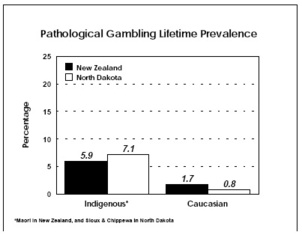Research on the prevalence of gambling among Native Americans on reservations and in substance abuse treatment in the United States has found that Native Americans have higher rates of pathological gambling than their non-Native American counterparts.*,** A recent analysis of previously collected data from New Zealand and North Dakota contributes more information to the limited knowledge about disordered gambling among native communities***. Volberg examined data from the Maori in New Zealand and the Sioux and Chippewa in North Dakota on the South Oaks Gambling Screen, participation in types of gambling activities, and sociodemographic items. A total of 4053 randomly selected adults in New Zealand were surveyed over the phone in 1991; Maori were oversampled because of the lower telephone ownership among this population. In North Dakota, 1517 randomly selected adults were surveyed in 1992; an additional purposive sample of 328 Native Americans was interviewed by phone, and 72 Native Americans were interviewed in person. This study compared these two groups of indigenous populations with their Caucasian counterparts. The findings state that in both countries, indigenous groups have significantly higher rates of both lifetime and current pathological gambling than the respective Caucasian group. These findings must be held as tentative, because other differences between these two groups also were evident. For example, on average, the indigenous adults were younger, less educated and had a lower household income than each of their Caucasian comparison group. If a group of younger, less educated, and lower SES Caucasians were compared to the same Caucasian comparison group, similar differences in estimates are likely. The dual-method survey strategy (i.e., phone vs. in-person interviews) in North Dakota may also have biased the estimates. These factors all exert influences on the observed rate of pathological gambling in every population sample. Therefore, while these studies offer support to the preliminary observation that indigenous people have higher rates of pathological gambling than Caucasians in New Zealand and North Dakota, more carefully designed and controlled research is necessary.
Sources: *Zitzow, D. (1996). Comparative study of problematic gambling behaviors between American Indian and non-Indian adults in a northern plains reservation. American Indian and Alaskan Native Mental Health Research, 7(2), 27-41; **Elia, C. & Jacobs, D.F. (1993). The incidence of pathological gambling among Native Americans treated for alcohol dependence. International Journal of Addictions, 28(7), 659-666; ***Volberg, R.A., & Abbott, M.W. (1997). Gambling and problem gambling among indigenous peoples. Substance Use & Misuse, 32(11), 1525-1538.
This public education project is funded, in part, by The Andrews Foundation.





